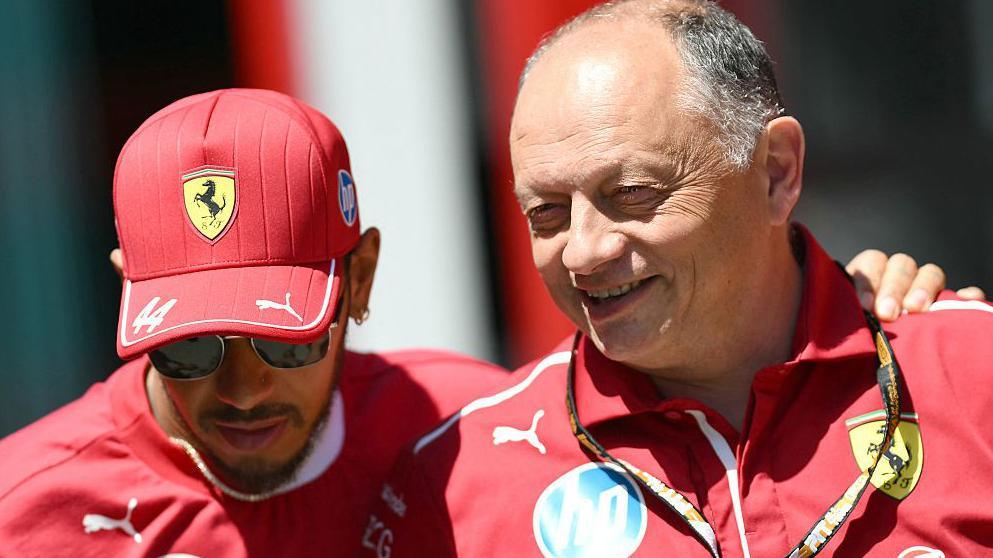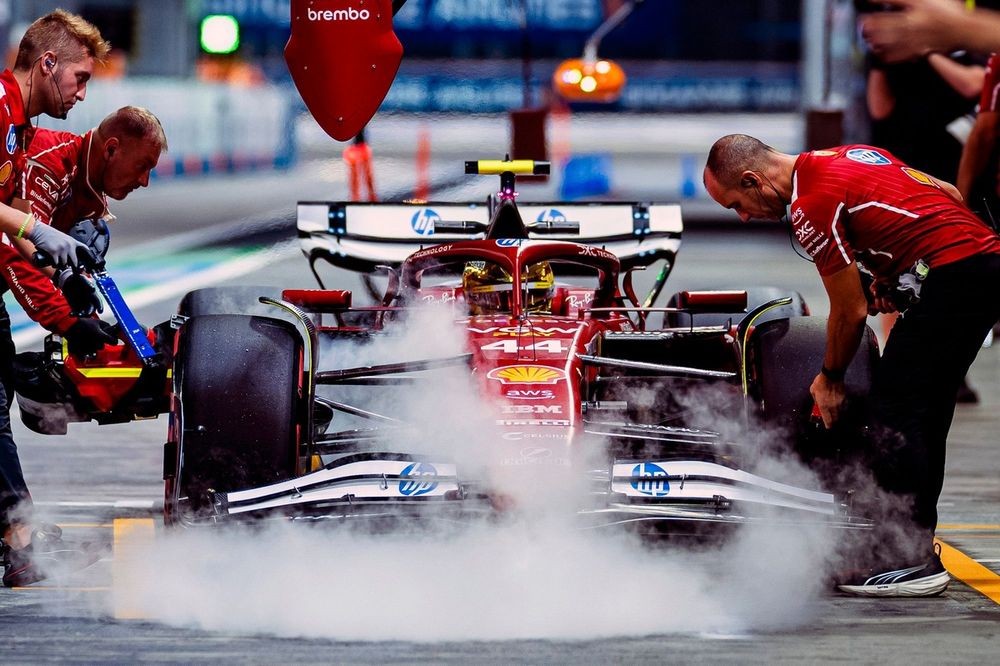The Mexican Grand Prix was supposed to be a celebratory moment, a sign that the relentless toil at Maranello was finally yielding fruit. For Lewis Hamilton, it was shaping up to be his most potent performance since trading silver for scarlet, a period that silenced critics and delivered a palpable sense of progress.
Yet, in a brutal twist of fate that has ignited a firestorm of controversy across the global motorsport community, that hard-earned success was snatched away by a decision from the FIA stewards that has been universally condemned by the Ferrari camp as “unacceptable” and a clear case of “double standards“.
The fury unleashed by Team Principal Fred Vasseur and the incandescent disappointment of Hamilton himself now echo far beyond the confines of the Autódromo Hermanos Rodríguez, demanding accountability for an inconsistency that threatens to destabilize the integrity of Formula 1 officiating.

The Duel and the Disproportionate Sentence
From the moment the lights went out, the Mexican air was electric, thick with the promise of a classic race. Hamilton, delivering a masterclass in car control and racecraft, was locked in a fierce, wheel-to-wheel duel with his old rival, Max Verstappen. The effort speaks volumes about the level of performance: Hamilton’s race pace was unequivocally there, culminating in a daring move that saw him briefly capture P3, putting him firmly on course for a well-deserved podium finish. This was pure, unadulterated racing, the kind of aggressive, yet controlled, effort that reminded everyone why the Brit is a seven-time World Champion.
The flashpoint occurred during this exhilarating battle, specifically at Turn 3. Pushing the limits of track boundaries in a desperate attempt to maintain position and momentum, Hamilton inevitably ran wide, his car taking “four wheels off the track” in an incident the stewards later labeled “unacceptable“. He was subsequently handed a crushing 10-second time penalty by the stewards for “allegedly gaining an advantage” on track. In the high-stakes environment of Formula 1, a 10-second addition is nothing short of a race-wrecking sentence, a penalty that immediately extinguished Hamilton’s podium dreams and threw a pall over the Ferrari garage.
The mood inside the Scuderia’s sanctuary turned instantly from electric anticipation to a mixture of shock, frustration, and mounting rage. As the broadcast cameras lingered, the exhaustion from the intense exchange between Hamilton and his engineer was palpable. They all knew the podium Hamilton had earned had been ripped away by a rule book interpretation that felt less like even-handed justice and more like a targeted, disproportionate punishment. As Hamilton himself noted, the sanction was “completely disproportionate” to the incident. It was unfair to see that effort undone, a sentiment echoed by many calling the decision purely a racing penalty over.
Vasseur’s Volcanic Pit Wall Reaction
Standing sentinel on the pit wall, Ferrari Team Principal Fred Vasseur’s reaction was a study in controlled volcanic anger. For a man who rarely allows his composure to slip, the fury was undeniable, “written across every line of his cameras”. His jaw was clenched, his arms crossed, a silent but potent manifestation of his internal storm. His eventual comments, though “restrained” in tone, delivered an “explosive” message that perfectly channeled the collective frustration of a team feeling unjustly persecuted.
Vasseur later minced no words, labeling the ruling an “unacceptable decision that ruin what could have been a great result for the team“. His shock was so profound that even his rare public show of emotion—shaking his head in “disbelief“—was noted across the paddock. The feeling was clear: a monumental step forward, a genuine sign that Hamilton was finally gelling with the car’s “nuances,” had been arbitrarily erased. The team had progress, only to have it “undone” by what Vasseur unequivocally saw as glaring inconsistency. The Frenchman’s assertion that 10 seconds is “far too much” highlighted the excessive nature of the punishment when the driver seemed to already be learning the nuances of the car.

The Smoking Gun of Inconsistency
What truly catapulted the paddock’s frustration into a full-blown public scandal was the irrefutable evidence of a double standard. The central pillar of the Ferrari and Hamilton critique is devastatingly simple: Max Verstappen, the same rival, in the “same race, same corner,” performed an “exact same battle” moments earlier, also taking “four wheels off cutting turn three“. The ruling? “No investigation. No penalty came his way“.
The side-by-side telemetry comparison, which quickly spread like wildfire across social media platforms, made the inconsistency impossible to ignore. Two identical track excursions in the heat of battle—one driver penalized with a devastating 10-second sanction, the other allowed to race on unhindered. As one section notes, rival team engineers were “quietly reviewing the evidence side by side” and “admitted the punishment was excessive“.
The sense of grievance for Hamilton was exacerbated by the technical analysis. As the seven-time champion articulated, he had “already paid the price by losing time and position” during the excursion itself, suggesting the action of going off track was not a gain but a necessary recovery that led to an organic time loss. The imposition of an additional 10-second penalty was therefore seen as completely disproportionate. His disappointment was raw: “I’m disappointed by the double world [standards], it’s frustrating like this ruin what could have been a great result for the team“. The frustration felt even deeper because Hamilton delivered “one of his strongest weekends” since joining Ferrari, a testament to his sheer, unadulterated “pure performance“.
A Collective Demand for Justice
The collective roar of the Ferrari fan base and the general F1 community was immediate and deafening. Social media threads were flooded with demands for justice, dissecting every frame of the onboard footage. Beyond the immediate result, this incident represents a significant blow to the FIA’s ongoing effort to “rebuild credibility”. When a team, led by figures as established as Vasseur and Hamilton, feels compelled to call out “selective enforcement” and “bias in enforcement’s internal analysis,” the questions raised transcend a single race result; they challenge the fundamental principles of fairness and transparency upon which elite motorsport must operate.
The incident forces every driver and team to ask a profound question: can they truly trust the officials to judge their races fairly? Can a team build strategy with confidence when the goalposts for permissible racing are seemingly moved depending on the driver involved? This was supposed to be Hamilton’s “breakthrough weekend,” a turning point where his integration with Ferrari culminated in a “proper result”. Instead, this moment has become “another chapter in a story of frustration,” a narrative of progress being “ruined” by outside, non-racing forces. This was pure racing undone, and Hamilton’s race engineer Ricardo Adami had “no answer” because “there wasn’t one that would make it right“.
The outrage and disappointment have been compounded by the knowledge that Hamilton was racing with clear, defined intention, not recklessness. The telemetry provided by Ferrari clearly shows he “lost over measured time in that sequence,” which reinforces the argument that the 10-second penalty was simply an overreach and a failure to consider the on-track consequences he had already endured. The very nature of the decision seemed to imply that the FIA “decided to make an example of it,” robbing him of a result he earned through sheer performance.

Moving Forward Through Fire
Despite the emotional wreckage of the moment, the response from Hamilton carries a powerful undertone of determination. While he was clear about his frustration and the sting of the double standards, his ultimate disposition is that of a champion who refuses to dwell on injustice. His last words captured in the available information offer a glimpse into his resilient mindset, a shift in tone somewhere between anger and resignation: “I don’t care I move forward“.
This setback is painful, particularly because it undermines the genuine “pure performance” that Hamilton delivered. Yet, the fury and the unified reaction from the entire Ferrari garage—from Vasseur on the pit wall to the mechanics reviewing the data—has arguably forged a new level of determination. It has turned a moment of singular injustice into a collective rallying cry. The Mexican Grand Prix did not just rob Hamilton of a podium; it provided a stark, undeniable confirmation that the fight for fairness in Formula 1 remains as fierce as the battles on the track. The question now is whether the governing body will respond to this “collective demand from the paddic” for clear, consistent rules, or if this saga of stolen glory will merely serve as a grim precedent. The next race, and the inevitable return to wheel-to-wheel action, will be the true test of whether the wounds inflicted in Mexico can be healed by a commitment to genuine sporting justice.